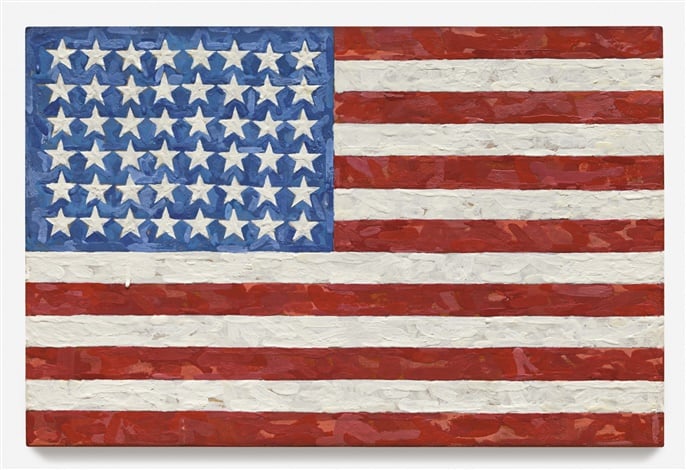Art Guides
Mystery Buyer of Jasper Johns Flag Dropped $87 Million At Sotheby’s Sale


Eileen Kinsella

The packed saleroom at Sotheby’s watched eagerly on Tuesday (November 11) as auctioneer Oliver Barker opened the bidding on Lot #9, Jasper Johns’s relatively small but brilliantly-colored and captivating Flag (1983) at $12 million (estimate $15 million–20 million). In no time at all the price leaped, in half-million and then million-dollar increments to the mid-20 million dollar mark as two Sotheby’s specialists on the phone with their respective clients went head to head for the work. It was eventually hammered down for Sotheby’s specialist Scott Nussbaum for $32 million. Including premium, the price was $36 million and set a new record for Johns, surpassing the previous high of $28.6 million.
Painted in 1983, Flag was acquired by the current consignor, a former Johns assistant, directly from the artist, and had never appeared at auction before. artnet News overheard collectors debating whether it might rank among the most expensive paintings per square inch and how the size compared to an iPad.
Flag also has a prestigious exhibition history: it had been on extended loans to the Yale University Art Gallery in New Haven, Connecticut (1999-2002) as well as to the Philadelphia Museum of Art (2007–14). Sotheby’s devoted a full 12-pages of its catalogue to the iconic work, complete with pictures of the painting in-situ in Philadelphia, close-ups of Johns’ masterful brushwork on the stars and stripes, pictures of American soldiers raising the flag at Iwo Jima, Apollo mission commander Eugene Cernan on the moon with the US flag in back, and mourners at the eulogy of President John F. Kennedy by his flag-draped coffin.
According to the Sotheby’s catalogue. the idea for the painting came to Johns in a dream. “Johns dreamt one night of painting a large American flag, and as the legend goes, the next morning he subsequently set out to do so…the encaustic paintings remain the most rarefied and sought after realization of his iconic idea.”
No word on who bought it yet but we do know that whoever Nussbaum’s client is, he or she was an extremely active bidder throughout the evening.
Among other purchases made by the same paddle number via Nussbaum: Mark Rothko‘s No. 21 (Red, Brown, Black and Orange), an early 1951 painting (and slightly less typical Rothko) with an unpublished estimate north of about $50 million that sold for just under $45 million with premium; a Joseph Cornell box construction, Untitled (Palais de Cristal) (circa 1953), which sold for $665,000, short of its $800,000 low estimate; Mark Tansey’s painting Landscape (1994), which sold for $3.7 million on an estimate of $3 million–4 million; and Louise Bourgeois‘s marble and stainless steel sculpture Distant Figures (1971), which sold for $1.8 million on an estimate of $1.5 million–2 million.
New York Times writer Carol Vogel fielded rumors that the buyer was Alice Walton, Wal-mart heiress and founder of the Crystal Bridges Museum of American Art in Bentonville, Arkansas. We reached out to the museum’s press department. A representative for the museum responded via email: “At this time we don’t have any information to share.”